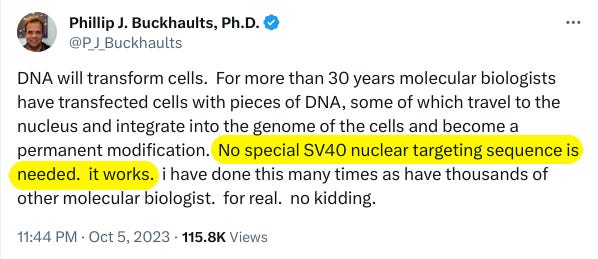Credit: Jikkyleaks for much needed assistance, to Cellex and Nilly for image assistance. AI research tools were used.
Since The Daily Beagle’s article showing plasmid DNA can integrate into cell DNA without the need for transfectant reagents, scientists have now been forced to change their tune from ‘the shots don’t change DNA’…
…to, ‘actually DNA changes happen all the time and are super-duper safe’ (from the people who brought you ‘safe and effective’):
What a difference a single article makes!
However, we now have to refute the obviously false ‘super-duper safe’ and ‘super-duper rare’ arguments (notice they [the pro-vaccine community] haven’t proven safety; merely assumed it; and they’ve already been wrong once…).
Laying The Groundwork
In-case you don’t trust The Daily Beagle’s reporting, Jikkyleaks also provided a peer-reviewed paper confirming plasmid DNA gets incorporated into the cell nucleus (‘nuclear envelope reformation at telophase’: this occurs during cell division):
This study finds the plasmid DNA ends up in chromosomes (chromosomes carry genes):
But, actually, it gets worse.
The DNA Becomes Inheritable
David A. Dean (Professor of Pediatrics, Biomedical Engineering, and Pharmacology & Physiology) was nice enough to get back in touch with a helpful peer-reviewed paper in an email (we previously spoke, as covered in the previous plasmids article).
Attached was a paper titled “Postmitotic Nuclear Retention of Episomal Plasmids Is Altered by DNA Labeling and Detection Methods”, and whilst it makes use of direct artificial micro-injection into a cell nucleus to simulate plasmid DNA entry, what it reveals is quite stunning:
It shows as the cell divides, the daughter cells will retain the DNA modification.
Once plasmid DNA enters the nucleus — whether via transfectant reagents, during cell division, via micro-injection or some other means — the genetic alterations propagate down the line of cell divisions to daughter cells. So, no, it is not ‘just one cell’.
And it gets worse. It propagates to the next generation.
SARS-CoV-2 Enables Penetration Of The Blood-Testis Barrier
Sertoli cells form a barrier that filters out foreign particulates from entering the testes, known as the Blood-Testis Barrier (BTB). Sertoli cells also support nourishment of developing sperm cells, so if damaged, also impacts sperm development (HART group reported this happened in those who received the shots).
The BTB is made up of Sertoli-Sertoli cell junctions forming ‘Tight Junction Proteins’, acting as filter. BTB protects seminiferous tubules and developing sperm cells.
Don’t worry if you’re not familiar with the terms, there will be an overview at the end.
In the study titled “COVID-19 disrupts the blood–testis barrier through the induction of inflammatory cytokines and disruption of junctional proteins”, it was found:
Papers also show cytokines like IL-1α, IL-6 etc (triggered by SARS-CoV-2 spike proteins) impact the BTB.
If the BTB gets disrupted, seminiferous tubules are no longer protected. BTB open up holes and ‘become leaky’, exposing the testes to foreign matter.
Why does this matter?
Seminiferous tubules contain Spermatogonia (not to be confused with sperm cells, known as Spermatozoa). Spermatogonia are special 'starter' cells, initial germ cells that give rise to a number of cells, which for simplicity are identified as:
Type A (dark): reserve stem cells, that continue to divide and replenish the pool of spermatogonia
Type A (pale): stem cells in the process of renewing
Type B: cells committed to differentiation, and are on the path to becoming sperm cells
This means, if seminiferous tubules become vulnerable, so do the cells that form the basis of generating sperm cells, the spermatogonia.
LNPs Enter The Testes (When They Shouldn’t)
The BTB breach means foreign elements like LNPs (lipid nanoparticles), plasmid DNA and mRNA can enter the testes, when normally they shouldn’t.
We can confirm this because in the Pfizer/BioNTech document published in “JW-v-HHS-prod-3-02418” (page 462) we see data showing LNP concentrations in the testes increasing (which we wouldn’t expect to happen if the BTB was working):
In graph form it looks like this, a very obvious increase over time:
Conveniently, Pfizer/BioNTech cut off the experiment after 2 days, likely trying to hide where LNPs were accumulating in various organs (where it shouldn’t).
LNPs are transfectant reagents capable of allowing plasmid DNA to enter cell DNA.
We can confirm the mechanism for a BTB breach, and show real world data of LNPs passing the BTB. This isn’t speculation: the testes are vulnerable to LNPs and thus foreign DNA incorporation.
What are the implications?
Spermatogonia Self-Perpetuate (The Kids Are Not Okay)
Once Spermatogonia take up foreign DNA, not only will the foreign DNA perpetuate itself to any additional spermatogonia the spermatogonia produces via cell division (as suggested by David A. Dean’s paper)…
…but it will also perpetuate itself to any sperm cells ultimately derived from the contaminated spermatogonia. Meaning any children produced from said sperm cells will also inherit the foreign DNA. We know this from testis-mediated gene transfer experiments.
And it gets worse…
Sperm Cells Really Like To Incorporate Foreign DNA
We know this from sperm-mediated gene transfer experiments. It is often used in transgene experiments:
Another term for sperm is spermatozoa (not to be confused with ‘spermatogonia’ mentioned earlier). Immature sperm are not capable of binding to foreign DNA:
However if LNPs can help plasmid DNA transfect cell DNA, then LNPs will allow plasmid DNA to enter the immature spermatozoa, as they are also cells.
Seminal Fluid Will Impede DNA Uptake (But Only If Present)
Additionally, whilst mature sperm cells themselves will readily accept foreign DNA, foreign DNA uptake by sperm is impeded by seminal fluid that contains an inhibitory factor preventing foreign DNA from binding in mature sperm.
This only applies if seminal fluid is present. If it isn’t, such as in the epididymis where immature sperm cells go on to become mature sperm cells (Spermatozoa), then they won’t be protected by seminal fluid:
Three Main Forms Of Entry For Sperm
To recap, there’s three main opportunities for the foreign DNA to incorporate into sperm:
Via Spermatogonia cells that produce both Spermatogonia cells and the pre-cursor cells that go on to form Spermatozoa (sperm cells)
Via immature sperm cells with the assistance of a transfectant reagent such as LNPs (which we know enter the testes) or SV40 promoter (which we know are likely in the plasmid DNA)
Via mature sperm cells in the epididymis in the limited window before they enter seminal fluid
The most harmful of these is incorporation of foreign DNA into Spermatogonia cells, as it retains a self-replicating form of permanence and produces additional compromised sperm cells.
Curiously, in our research into cancer cases, we found prostate (which, along with the seminal vesicles, produce seminal fluid) cancer cases had skyrocketed:
You will not want to hear these words: but it gets worse.
Female Eggs Are Vulnerable Too
We’ll let the graph based on some data from “JW-v-HHS-prod-3-02418” (pages 461-462) on LNP (lipid nanoparticles) biodistribution do the talking:
Or this particularly stunning example from Jikkyleaks in response to Buckhaults, showing LNPs in the ovaries of a mouse:
The image comes from the study “Synthetic Lipid Nanoparticles Targeting Steroid Organs”.
As you’ll notice the LNPs, which are capable of allowing plasmid DNA to enter cell DNA, are accumulating in the ovaries, besides other organs.
The ova (singular: ovum), also known as the human egg cell, located in the ovaries, is protected from foreign DNA by the Zona Pellucida (via glycoproteins), which is found on the outer layer:
The LNPs being concentrated in the ovaries would likely overcome the protections of Zona Pellucida and cause DNA to be incorporated by the egg cell. But even if they didn’t…
…as you’re probably guessing by now, protection only applies if the Zona Pellucida is even there in the first place. It is absent in immature egg cells (known as ‘oocytes’), and researchers have already successfully transfected oocytes using both adenoviruses and plasmids:
As mentioned in the article “Editing The Truth: mRNA Shots Modify Genes”, the Moderna and Pfizer/BioNTech mRNA shots contain plasmids, and as noted in the article “Proving AstraZeneca Vaccines Kill Children” the Astrazenca, Johnson&Johnson and Sputnik V shots use adenoviruses.
And finally, in response to the endless ‘it is safe for pregnancy’ shilling by those with financial conflicts of interest they won’t publicly disclose, Dr Syed wrote an in-depth rebuttal.
In Summary
We can therefore infer that the genetic alterations are likely to impact the next generation, and it isn't as simple as a handful of random cells having their DNA altered.
Scientists are now acknowledging plasmid DNA can enter cells even without transfectant reagents, as confirmed both by peer-review paper provided by Jikkyleaks and David A. Dean's work.
Plasmid DNA becomes inheritable by daughter cells' nuclei DNA during cell division, meaning the next generation of cells retain foreign DNA modification.
SARS-CoV-2 impacts Sertoli cells that form 'Tight Junction Proteins' forming the Blood-Testis Barrier (BTB), modifying it via cytokine interactions (such as IL-1α, IL-6), causing BTB to become leaky, and permitting foreign particulate entry to the testes and the seminiferous tubules where Spermatogonia reside. We know this because Pfizer/BioNTech LNPs (lipid nanoparticles) biodistribution shows LNPs entering into the testes when normally they shouldn't.
Spermatogonia form several cells (Type A (dark); Type A (pale); Type B), including other Spermatogonia cells (Type A (dark)) and sperm pre-cursor cells (Type B) that will go on to eventually become Spermatozoa (mature sperm cells).
If Spermatogonia incorporate foreign DNA, they will pass it onto daughter cell Spermatogonia and Type B cells that will become Spermatozoa (mature sperm cells), meaning foreign DNA residency is likely permanent and passes onto the next generation of children if the compromised sperm inseminates an ovum.
Mature sperm cells (Spermatozoa) have naturally occurring mechanisms for incorporating foreign DNA, usually inhibited by seminal fluid, however during maturation in the epididymis they won't be protected by seminal fluid.
Immature sperm cells lack the ability to naturally incorporate foreign DNA, however LNPs have been shown to cause foreign DNA uptake into cells, and as immature sperm cells are still cells, LNPs can cause the DNA uptake to still occur. There has been a noticably huge spike in cancer cases post-shot rollout relating to the prostate, which is part of seminal fluid production.
Human female eggs are also vulnerable. Even though fully mature ova are protected from foreign DNA due to Zona Pellucida, documents from Pfizer/BioNTech and a peer-reviewed paper shows LNPs (lipid nanoparticles) concentrate in the ovaries, meaning LNPs would likely overcome any resistance by the Zona Pellucida to foreign DNA entry.
Even if they did not, as oocytes (immature ova) they have been shown to vulnerable to transfection from adenoviruses and plasmids. The mRNA shots have been shown to contain plasmids; AstraZeneca, Johnson&Johnson and Sputnik V shots use adenoviruses.
This shows the shots pose risk of harms in pregnancy, and the next generation, contrary to what those with financial conflicts of interest would say.Related Articles To Read
Found this informative? Receive more for free!
Raise awareness?
What do you think, dear reader? Let us know in the comments.





























Today's magic word: DNA micro-chimerism.
Try punching that into your search.
This looks increasingly plausible:
https://open.substack.com/pub/jessicar/p/remember-that-4chan-post-from-2020?r=rfcvr&utm_medium=ios&utm_campaign=post